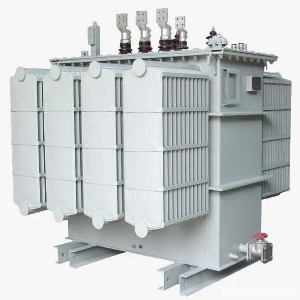Electronic Components Supplier | Transformers, Inductors, Inverters
PRODUCT PARAMETERS
Description
1、 Overview of 35kV oil-immersed power transformer
The 35kV oil-immersed power transformer is the core equipment in the transmission and distribution system, mainly used to convert the 35kV (kilovolt) voltage level into 6kV, 10kV or other lower distribution voltages, achieving efficient transmission and distribution of electrical energy. As the “heart” of the power network, it is widely used in substations, industrial and mining enterprises, power plants, urban power grids, and various large-scale infrastructure due to its high reliability, large capacity, long lifespan, and economy.
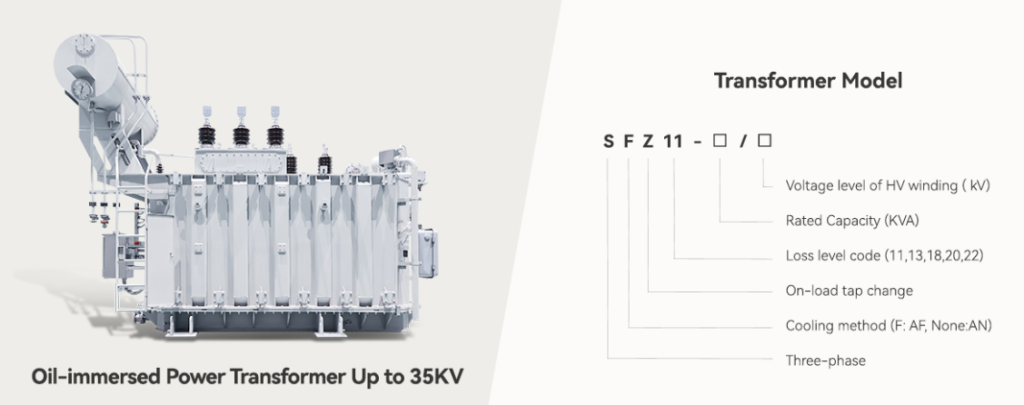
Components of oil-immersed transformer
2、 Main structural components
The structural design of oil-immersed transformers is precise, and all components work together to ensure their stable operation.
2.1 Body (core part):
Core: It is usually made of high-quality cold-rolled grain oriented silicon steel sheets, using a stepped multi-stage joint process to reduce magnetic resistance and eddy current losses, improve magnetic permeability, reduce no-load losses and operating noise.
Winding: divided into high voltage winding and low voltage winding, usually made of copper foil or copper wire winding, and insulated with insulation materials for interlayer and turn insulation. The winding structure determines the electrical performance and short-circuit resistance of the transformer.
2.2 Fuel tank and cooling system:
Oil tank: The outer shell, inner body, and transformer oil of the transformer have good sealing and mechanical strength.
Transformer oil: mainly serves the dual functions of insulation and cooling. It has good insulation strength, thermal stability, and fluidity.
2.2.1Cooling device: According to the capacity, common cooling methods include:
- ONAN (oil immersed self cooling): relies on natural convection of oil and natural circulation of air for heat dissipation. Suitable for small and medium-sized transformers.
- ONAF (Oil Immersed Air Cooling): Installing a fan on the radiator to forcefully blow air and dissipate heat, significantly improving heat dissipation efficiency. Suitable for medium to large capacity transformers.
- OFAF (forced oil circulation air cooling): using an oil pump to force transformer oil circulation, supplemented by a fan for strong cooling, used for large transformers.
2.2.2Protection system:
- Oil storage tank (oil pillow): compensates for the volume expansion and contraction of transformer oil caused by temperature changes, reduces the contact between oil and air, and delays the aging of oil.
- Moisture absorber (respirator): equipped with silicone desiccant to absorb moisture from the air entering the oil storage tank and keep the inside of the transformer dry.
- Gas relay (gas relay): installed on the connecting pipe between the oil tank and the oil storage tank. When there is a minor fault (producing a small amount of gas) or a serious fault (oil flow impact) inside the transformer, an alarm or trip signal will be issued.
- Pressure relief valve: When the internal fault of the transformer causes a sharp increase in pressure, it can quickly open to release the pressure and prevent the oil tank from exploding.
- Temperature gauge: Real time monitoring of the top oil temperature of the transformer, and providing over temperature alarm and trip signals.
Outgoing device:
High voltage bushing and low voltage bushing: achieve electrical connection between internal windings and external lines, while ensuring reliable insulation to ground.
3、 Core features and advantages
- High insulation strength and reliability: The insulation performance of transformer oil is much better than that of air, making the transformer structure more compact, with extremely high insulation reliability, and able to withstand lightning strikes and operating overvoltages.
- Excellent heat dissipation performance: The oil has a high specific heat capacity and good fluidity, which can effectively remove the heat generated by the iron core and winding, and dissipate it into the air through the radiator, ensuring the long-term stable operation of the transformer under rated load.
- Powerful overload capacity: With a large thermal capacity, it allows for a certain degree of overload operation in a short period of time.
- Long service life: With proper design specifications and maintenance, the service life can reach 20-30 years or even longer.
- Mature technology and rich maintenance experience: As the most classic type of transformer, its design, manufacturing, operation, and maintenance technology are very mature and highly recognized in the market.
- Good economy: Compared to dry-type transformers of the same voltage level, oil immersed transformers have more advantages in manufacturing costs and product prices, especially in the field of large capacity.
4、 Main technical parameters
When choosing a transformer, the following key parameters should be considered:
- Rated capacity: such as 2000kVA, 3150kVA, 5000kVA, 10000kVA, etc.
- Rated voltage: 35kV ± 2 × 2.5% or ± 5% on the high voltage side (tap range), 10.5kV or 6.3kV on the low voltage side, etc.
- No load loss (P ₀) and load loss (P ₋): are key indicators for measuring the energy efficiency level of transformers, with lower values indicating greater energy savings.
- Short circuit impedance (U ₋%): usually 6.5% -8%, affecting the magnitude of short-circuit current and voltage stability.
- Connection group label: The most commonly used is Dyn11, which has the advantages of suppressing high-order harmonics and strong ability to withstand unbalanced loads.
- Cooling methods: such as ONAN, ONAF.
- Noise level: Sound pressure level that meets national standards, such as ≤ 65 dB (A).
5、 Application scenarios
35kV/10kV regional substation: As the main transformer, it reduces the 35kV transmission voltage to the 10kV distribution voltage.
Large industrial and mining enterprises: general voltage reduction stations for enterprises such as steel, chemical, non-ferrous metals, etc.
New energy power plants, such as wind farms and photovoltaic power stations, use boosting stations to increase the generator voltage to 35kV and connect it to the grid.
Railway traction substation.
Urban infrastructure: core substations such as airports, subways, and large data centers.
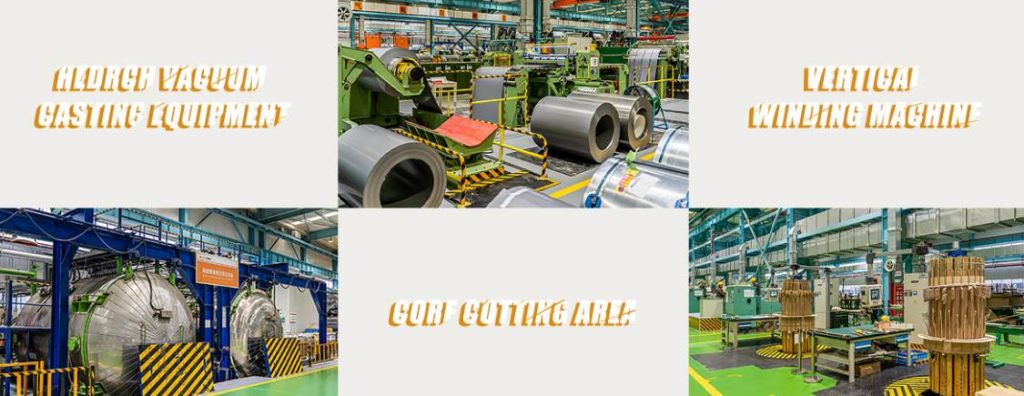
Scene diagram of transformer production workshop
6、 Selection precautions
- Capacity selection: Based on the calculation load, expected growth, and economic operating point (usually a load rate of 50% -70%), it is determined comprehensively to avoid “big horses pulling small cars”.
- Energy efficiency level: Choose energy-saving products that meet higher levels (such as level 2, level 1) of Chinese energy efficiency standards (such as GB 20052) to reduce long-term operating costs.
- Operating environment: Consider factors such as altitude, ambient temperature, and pollution level of the installation location, which can affect the insulation and cooling design of the transformer.
- Protection configuration: Ensure that the supporting protection devices (relay protection, fuses, etc.) are complete and set correctly.
- Brand and after-sales service: Choose reputable manufacturers and ensure timely technical support and spare parts supply.
7、 Development Trends
Energy saving and environmental protection: Promote the use of amorphous alloy iron core transformers, which can reduce no-load losses by 60-70% compared to traditional silicon steel sheet transformers. At the same time, we are developing environmentally friendly transformer oil with high ignition point and biodegradability.
Intelligence: Integrated online monitoring system, real-time monitoring of dissolved gases in oil, partial discharge, winding temperature, iron core grounding current and other state parameters, achieving predictive maintenance and intelligent management.
High reliability: By optimizing electromagnetic and structural design, the short-circuit resistance and mechanical strength of transformers can be further improved.
35kV oil-immersed power transformers still occupy an irreplaceable dominant position in today’s power system due to their mature technology, excellent performance, and economic cost. With the application of new materials, new processes, and intelligent technologies, it is continuously developing towards greater efficiency, environmental friendliness, and intelligence.
REQUEST A QUOTE
RELATED PRODUCTS
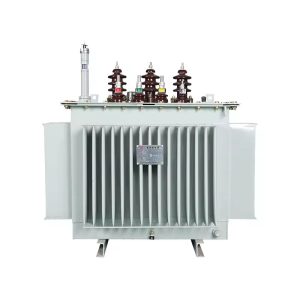
10kV oil immersed transformer
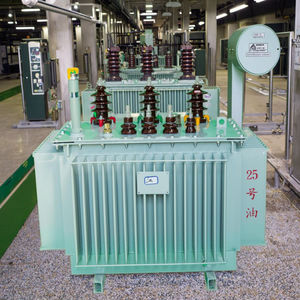
S11 S13 220V Oil Immersed Multifunctional Industrial Copper Transformer
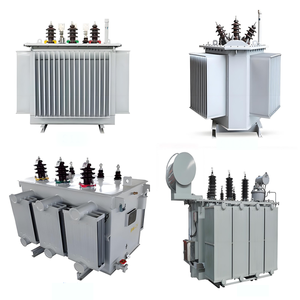
Economical Bulk General Distribution Transformer 11kv 33KV Input Voltage With 400v 220v 11kv Output Voltage Options
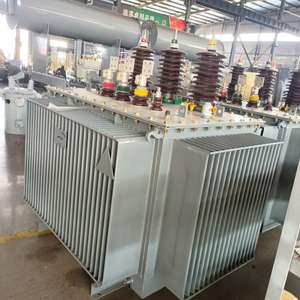
Whole High Quality Transformer 15kv 630kva Oil-immersed Transformer Distribution Transformer
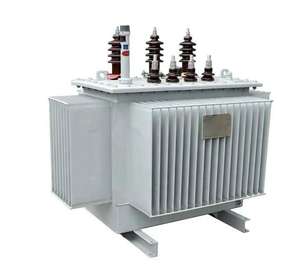
Small Electrical Transformer 50kva 100kva 200kva Power Amplifier Transformer



